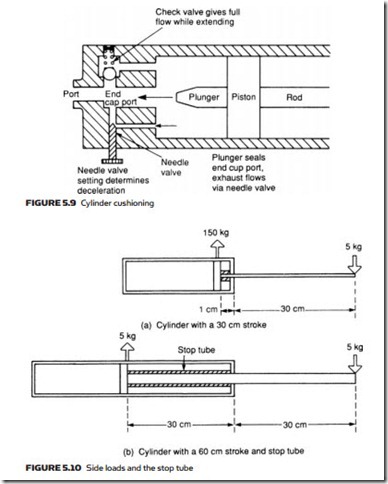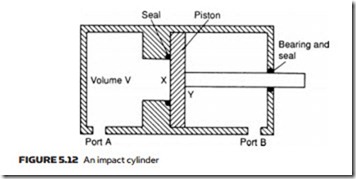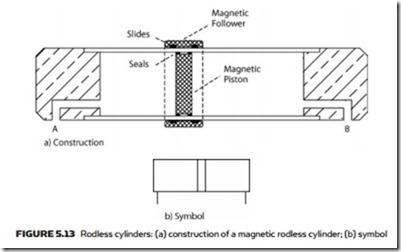construction
Pneumatic and hydraulic linear actuators are constructed in a similar manner, the major differences arising out of differences in operating pressure (typically 100 bar for hydraulics and 10 bar for pneumatics, but there are considerable deviations from these values).
Figure 5.7 shows the construction of a double-acting cylinder. Five locations can be seen where seals are required to prevent leakage. To some extent, the art of cylinder design is in choice of seals, a topic discussed further in a later section.
There are five basic parts in a cylinder: two end caps (a base cap and a bear- ing cap) with port connections, a cylinder barrel, a piston and the rod itself. This basic construction allows fairly simple manufacture as end caps and pistons are common to cylinders of the same diameter, and only (relatively) cheap barrels and rods need to be changed to give different length cylinders. End caps can be secured to the barrel by welding, tie rods or by threaded connection. Basic constructional details are shown in Figure 5.8.
The inner surface of the barrel needs to be very smooth to prevent wear and leakage. Generally a seamless drawn steel tube is used which is machined (honed) to an accurate finish. In applications where the cylinder is used infrequently or may come into contact with corrosive materials, a stainless steel, aluminum or brass tube may be used.
Pistons are usually made of cast iron or steel. The piston not only transmits force to the rod, but must also act as a sliding bearing in the barrel (possibly with side forces if the rod is subject to a lateral force) and provide a seal between high- and low-pressure sides. Piston seals are generally used between piston and barrel. Occasionally small leakage can be tolerated and seals are not used. A bearing surface (such as bronze) is deposited on to the piston surface then honed to a finish similar to that of the barrel.
The surface of the cylinder rod is exposed to the atmosphere when extended, and hence liable to suffer from the effects of dirt, moisture and corrosion. When retracted, these antisocial materials may be drawn back inside the barrel to cause problems inside the cylinder. Heat-treated chromium alloy steel is generally used for strength and to reduce effects of corrosion. Alternatively the rod may be plated with chromium which is then polished to give a smooth, corrosion-resistant surface.
A wiper or scraper seal is fitted to the end cap where the rod enters the cylinder to remove dust particles. In very dusty atmospheres external rubber bellows may also be used to exclude dust (Figure 5.8a) but these are vulnerable to puncture and splitting and need regular inspection. The bearing surface, usually bronze, is fitted behind the wiper seal.
An internal sealing ring is fitted behind the bearing to prevent high-pressure fluid leaking out along the rod. The wiper seal, bearing and sealing ring are sometimes combined as a cartridge assembly to simplify maintenance. The rod is generally attached to the piston via a threaded end, as shown in Figure 5.8b and c. Leakage can occur around the rod, so seals are again needed. These can be cup seals (as in Figure 5.8b) which combine the roles of piston and rod seal, or a static O ring around the rod (as in Figure 5.8c).
End caps are generally cast (from iron or aluminum) and incorporate threaded entries for ports. End caps have to withstand shock loads at extremes of piston travel. These loads arise not only from fluid pressure, but also from kinetic energy of the moving parts of the cylinder and load.
These end of travel shock loads can be reduced with cushion valves built into the end caps. In the cylinder shown in Figure 5.9, for example, exhaust fluid flow is unrestricted until the plunger enters the cap. The exhaust flow route is now via the deceleration valve which reduces the speed and the end of travel impact. The deceleration valve is adjustable to allow the deceleration rate to be set. A check valve is also included in the end cap to bypass the deceleration valve and give near full flow as the cylinder extends. Cushioning in Figure 5.9 is shown in the base cap, but obviously a similar arrangement can be incorporated in bearing cap as well.
Cylinders are very vulnerable to side loads, particularly when fully extend- ed. In Figure 5.10a a cylinder with a 30 cm stroke is fully extended and subject to a 5 kg side load. When extended there is typically 1 cm between piston and end bearing. Simple leverage will give side loads of 155 kg on the bearing and 150 kg on the piston seals. This magnification of side loading increases cylinder wear. The effect can be reduced by using a cylinder with a longer stroke, which is then restricted by an internal stop tube, as shown in Figure 5.10b.
The stroke of a simple cylinder must be less than barrel length, giving at best an extended/retracted ratio of 2:1. Where space is restricted, a telescopic cylinder can be used. Figure 5.11 shows the construction of a typical double-acting unit with two pistons. To extend, fluid is applied to port A. Fluid is applied to both sides of piston 1 via ports X and Y, but the difference in areas between sides of piston 1 causes the piston to move to the right.
To retract, fluid is applied to port B. A flexible connection is required for this port. When piston 2 is driven fully to the left, port Y is now connected to port B, applying pressure to the right-hand side of piston 1, which then retracts.
The construction of telescopic cylinders requires many seals, which makes maintenance complex. They also have smaller force for a given diameter and pressure, and can only tolerate small side loads.
Pneumatic cylinders are used for metal forming, an operation requiring large forces. Pressures in pneumatic systems are lower than in hydraulic systems, but large impact loads can be obtained by accelerating a hammer to a high velocity then allowing it to strike the target.
Such devices are called impact cylinders and operate on the principle illustrated in Figure 5.12. Pressure is initially applied to port B to retract the cylinder. Pressure is then applied to both ports A and B, but the cylinder remains in a retracted state because area X is less than area Y. Port B is then vented rapidly. Immediately, the full piston area experiences port A pressure. With a large volume of gas stored behind the piston, it accelerates rapidly to a high velocity (typically 10 m s−1).
When fully extended a conventional cylinder and rod occupies at least twice the length of the stroke. In many applications, such as automatic sliding doors, there is insufficient space to mount a piston/rod cylinder assembly.
Rodless cylinders mount a piston follower on the outside of the cylinder. The simplest construction, shown in Figure 5.13a, uses a magnetic external follower to track the position of a magnetic piston. The maximum force that this type of cylinder can provide is set by the breakaway force between the piston and the follower.
An alternative, but more complex, design has a physical connection between the piston and the follower. This connection link passes through a slot in the cylinder wall which is sealed by magnetic strip seals either side of the link. Al- though capable of providing the full force of which the cylinder is capable, the seal is vulnerable to dust intrusion which may cause leaks from the seal.
Sequencing applications, particularly those controlled by PLCs, often need to know the position of cylinders. Although conventional limit switches can be mounted to moving parts of the controlled plant it is often cheaper and simpler to use cylinders with integral end of travel limit switches. The piston in the cylinder is made of magnetic material or has embedded magnets and operates simple reed switches mounted on the outside of the cylinder barrel. The reed switches are usually strapped to the barrel with jubilee clips to allow accurate setting of the actuation position. Chapter 8 describes sequencing applications in detail.




